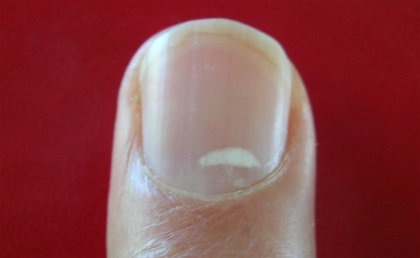
White spots on the fingernails belong to the most common ‘nail abnormalities’. Many people associate these whith spots with a calcium deficiency. However, the truth is that usually they do not relate to any’ health’ problem at all! A white spot is usually caused by a minor finger-related trauma!
In medical sciences a white spot on a fingernail is known as ‘leukonychia punctata’ – this name relates to the availability of nucleated keratinocytes.
NOTICE: A narrow white line in the nail – a.k.a. ‘transverse leukonychia’ – is another type of nail disorder.
White spots are typically caused by random minor trauma – including: pushing nail cuticles, or ‘nervous’ cuticle picking! This explains why white spots in nails are often seen in the hands of children!
White spots & zinc deficiency?
 Despite that white spots are usually the result of a minor physical trauma, studies have shown that sometimes white spots can be the result of a zinc deficiency – so that should not be confused with the unfounded folklore tail that white spots in a fingernail might indicate a calcium deficiency! (See for example: Fingernail white spots: possible zinc deficiency)
Despite that white spots are usually the result of a minor physical trauma, studies have shown that sometimes white spots can be the result of a zinc deficiency – so that should not be confused with the unfounded folklore tail that white spots in a fingernail might indicate a calcium deficiency! (See for example: Fingernail white spots: possible zinc deficiency)
Interestingly, in this perspective there even appears to be a connection between zinc definciency & trauma: stress! And in the field of palm reading professional palm readers have observed that white spots typically manifest in the fingernails when people experience a higher amount of stress than they usually do.
But in general, one should not expect to find a zinc deficiency when a person has only a few white spots. Because actually, a number of conditions can arise from a lack of zinc. One of the most important, which also lead to its discovery, was the stunting of growth and the lack of sexual development in adolescent boys; adding zinc to the diet brought about a rapid improvement. Skin complaints such as dermatitis and a condition called acrodermatitis in babies may result from deficiency, and there may be slow healing of burns and wounds. So zinc deficiency may show up as white spots or bands on fingernails, but probably only when other conditions manifest as well!
More details are discussed in the following topic at the Modern Hand Reading Forum:
http://www.modernhandreadingforum.com/t201p15-white-spots-on-nails-leukonychia
White spots & calcium deficiency?
 This part of the ‘folklore’ is not true. The Asia Pacific Journal of Clinical Nutrition reports:
This part of the ‘folklore’ is not true. The Asia Pacific Journal of Clinical Nutrition reports:
“There is no evidence to support a relationship between the white flecks and calcium or any other nutritional deficiency. Of course it is possible that people who have white flecks in their fingernails may coincidentally be deficient in calcium. White spots in fingernails may result from minor damage caused by bumping the nails into hard surfaces like bench tops or machinery. These white flecks are different from the white bands that are observed in nails of some undernourished children in developing countries, and in people who have low blood protein levels for various reasons.”
Conclusion: white spots do NOT indicate a calcium deficiency!
SUGGESTION FOR FURTHER READING:
• What are the most common nail disorders?
• Fingernail disorders & medical hand analysis!
Visibility of Blood Vessels in the Proximal Nailfold is a Biological Marker for Schizophrenia!
June 16, 2011
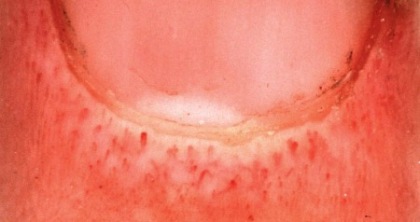
Visibility of the nailfold blood vessels plexus has been known for a long time as a biological marker in schizophrenia.
Schizophrenia became known for a high occurence of minor physical anomalies (MPA’s). Interestingly, one of the typical MPA’s in schizoprenia concerns visibility of the blood vessels in the proximal nailfold – a.k.a. ‘nailfold plexus visibility’ (NPV – which requires the use of a microscope for proper assessment). It concerns a minor developmental abnormality that has been studied as a hand marker for schizophrenia, but which lies outside the scope of the traditional MPA construct. Because nail fold plexus is commonly seen in the hands of young children, but not in adults. The statistics show that a high level of nailfold plexus visibility is relatively rare in the general population (occurring in 3-7% of healthy adults) while the rate of high NPV ranges from 20-70% in populations with schizophrenia (Curtis et al., 1999).
Interestingly, over the years studies have suggested this hand characteristic is specificly related to the so-called ‘negative symptoms’ in schizophrenia (which are associated with deficits of normal emotional responses or of other thought processes). And EEG studies have revealed that this nail fold blood vessel condition may mark a process associated with abnormal brain development leading to schizophrenia – including: an inverse relationship between plexus visibility and lateral ventricle size in the brain. The PVS is reliably determined and stable over time. Interrater reliabilities for PVS reportedly range from .83 to .99 (Buchanan and Jones 1969; Maricq 1966).
Taken together, researchers have concluded that findings on MPAs indicate that these minor anomalies appear to be part of some schizophrenia syndromes, representing a stable systemic or physical set of manifestations of the underlying neurodevelopmental processes that lead to the illness. This might explain why in the DSM-V the term ‘schizophrenia’ may be get replaced by the name ‘psychosis risk syndrome‘.
 BLOOD SUPPLY IN THE SKIN:
BLOOD SUPPLY IN THE SKIN:
The skin has a profuse blood supply, which is important in temperature regulation. The subcutaneous arteries form a network in the subcutaneous tissue, and from this is derived a subpapillary plexus in the dermis. Capillary loops in the dermal papillae arise from the subpapillary plexus, and from these loops the avascular epidermis is bathed in tissue fluid. A subpapillary plexus of venules gives the skin its pink color: the vessels become dilated when the skin is heated, and thereby make it look red.
NAILFOLD PLEXUS VISIBILITY & PSYCHOPATHOLOGY:
Just like is seen in the perspective of minor physical anomalies, nailfold plexia visibility is much more common in schizophrenia than in any other form of psychopathology. Studies have revealed that nailfold plexia visibility in schizophrenia is (much) more common than in other psychotic- & mood disorders – but these other disorders also show higher occurence than seen in the general population.
Studies have also shown that that patients with schizophrenia with a highly visible plexus have greater oculomotor dysfunction, negative symptoms, symptom severity, chronic course, and neuropsychological dysfunction. Furthermore, nailfold plexus visibility appears to be at least moderately heritable.
NAILFOLD PLEXUS & OTHER DISORDERS:
Other studies have revealed that nail fold plexus visibility has also been linked with hand markers in rheumatoid arthritis & hand markers in psoriasis. The pronounced subpapillary plexus visibility, greater number of vessels and their elongation are indicative of rheumatoid arthritis, while shorter, fewer capillaries and especially characteristic psoriatic capillaries, when present, suggest psoriatic arthritis.
Changes of nailfold capillary patterns have been described in certain patients with systemic sclerosis, dermatomyositis, mixed connective tissue disease, and Raynaud’s syndrome.
NOTICE: The nail tutor demonstrates how other nail fold characteristics can be associated with specific medical problems. More details about how to recognize various stages/variants of proximal nailfold blood vessels visibility in a palm reading, are presented in the picture below.
A phantom picture for the hand in schizophrenia is available here:
http://www.multiperspectivepalmreading.com/hands-schizophrenia-palm-reading.htm
Nailfold plexus changes are characterized by loss of (drop-out) nailfold capillary loops that surround the remaining, enlarged dilated capillaries. Upper left, A normal nailfold capillary pattern shows the uniform morphology and homogeneous disitribution of the small capillary loops just below the cuticle. Upper right, Capillaroscopy in a patient with systemic sclerosis illustrates dilatation of isolated capillary loops, with loss of surrounding loop structures. Lower right, The abnormal pattern is from a patient with childhood dermatomyositis. Dilated capillary loops are present, as well as areas of arborized clusters of capillary loops. Lower left, Distortion of the normal capillary loop architecture is seen in a patient with adult dermatomyositis. Note the loss of normal homogeneous distribution of the capillaries and the alterations in the morphology of the vessels, including the dilated and enlarged “giant” capillary loops.
Your fingernails are like the ‘rings of a tree’: they provide a window to changes in your body during the past six months. And fingernail changes likewise provide clues about changes in your health: because it takes about 6 months to grow out a full nail out of a finger (a fingernail grows about 0.1 mm per day).
How to recognize healthy fingernails? A healthy fingernail is characterized by: a smooth, rounded nail plate with a rectangular shape (at the corners slightly rounded). It’s color is pink, and at least the thumb requires to have a white crescent shaped lunula – in most people the lunula is not seen on the pinky fingers (some people have lunulae in all fingers where they take at most 1/3 of the pink area in the nail plate).
FINGERNAIL CHANGES:
Nail changes often reflect changes in the body. Medical science has identified & described literally hundreds different types of nail changes, and quite some of them have a highly significant correlation with the development of all kinds of diseases. But usually nail changes only rarely have a significance for a specified disease.
But nail changes can also indicate high stress, physical traumas, hormone changes, and even an unhealthy food pattern. But often it takes some time to monitor the nature of the changes seen in the nails!
And there Multi-Perspective Palm Reading can become involved, and even play a decisive role in the diagnosis process of the nail changes. Because Multi-Perspective Palm Reading describes the significance of nail changes in specified diseases, plus an overview of the other typical hand characteristics in those diseases. And therefore it can become very helpfull to find the true cause of nail changes when there are multiple options left according ‘the science of the fingernails’.
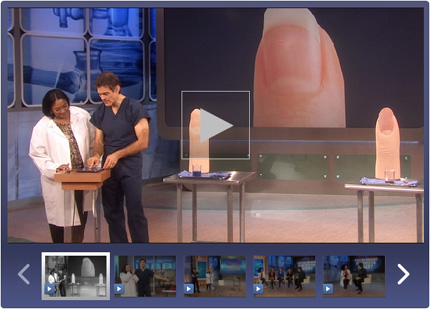 Dr. Oz – who became for his appearances in The Oprah Winfrey Show from 2004 until 2009, has presented a 6-minute Masterclass introduction to how your fingernails can provide you a window to your health, titled:
Dr. Oz – who became for his appearances in The Oprah Winfrey Show from 2004 until 2009, has presented a 6-minute Masterclass introduction to how your fingernails can provide you a window to your health, titled:

- Yellow nails
Your fingernails are not only a barometer of your general health state, sometimes they can also signal the presence of a medical problem! Why do nails turn yellow? And how to discriminate yellow nails from the ‘yellow nail syndrome’?
Yellow fingernails are often the result of behavior habits: such as smoking, nail polish, cooking with curry, nail fungus, or the use of certain types of medication (e.g. tetracycline).
YELLOW NAILS DUE TO A MEDICAL PROBLEM?
But sometimes nails may take a yellowish teint which is not the result of behavior. Fingernails that are yellow can be an indication of a medical disorder in some cases. These include liver disease, lung disease, diabetes, kidney disease, and nutritional deficiencies, most notably iron and zinc. Although most cases of yellow nails are not caused by an internal disorder, underlying medical problems should be ruled out if your nails have suddenly changed in color. Simple blood tests can generally rule out most causes of a yellow fingernail.
YELLOW NAIL SYNDROME?
The ‘yellow nail syndrome‘ is a rare nail disorder characterized by yellow to yellow-green, thickening, slowgrowing nail changes – with absent lunula and cuticle: see the picture below. The underlying pathological process if thought to be related to impaired lymphatic drainage.
THE NAIL TUTOR DESCRIBES THE MOST COMMON CAUSES
FOR YELLOWISH DISCOLORATION OF VARIOUS PARTS
OF THE NAIL UNIT:
YELLOW FREE EDGE – YELLOW HYPONYCHIUM
YELLOW LATERAL FOLD – YELLOW LUNULA
 Example of the yellow nail syndrome:
Example of the yellow nail syndrome:
Dr Oz demonstrates how fingernails relate to your health: spoon nails – pigmented bands – nail beading!
February 5, 2011
The state of your nails can say a lot about your health. Dr. Oz revealed in 2008 how to assess the health of your fingernails, and he described 3 conditions your nails are trying to tip you off to: ‘spoon nails’, ‘pigmented bends’ and ‘nail beading’.
If you have not heard of these problems before, then this could be very interesting! Doctor Oz said that most people do not examine their nails, but the color, shape and texture of your nails could be major warning signs of medical issues. First of all, you should feel the texture of your nail and look for a rounded shape. Dr Oz said other healthy nail characteristics include a nail being rectangular in shape and having a Lunula, a white crescent shape towards the base of the nail (especially in the thumb nail).
NOTICE: Be aware that the nail conditions may not be always a reliable indicator for the medical problems mentioned – a thorough health assessment is always required to make a diagnosis.
Spoon nails: iron deficiency?
Dr Oz said that spoon nails (koilonychia) are where you can imagine scooping out the center portion of your nail with a spoon. When water touches your nail, it sits on top and accumulates rather than rolling off. Dr Oz said that Iron Deficiency can cause Spoon Nails. When you have Spoon Nails, your blood supply cannot get to the center of your nail to make it grow strong.
Pigmented bands: melanoma?
Dr Oz said that healthy nails should be pink, but if you have dark vertical stripes on your nails (pigmented bands), especially if you are African American, this could be a sign of melanoma. There are also non-cancerous bands, but you must have a doctor examine it to find out.
Nail beading: thyroid problems?
Dr Oz said that you can get nail beading, which looks somewhat like the texture that builds on the side of candle as it burns and drips the wax down the side. After Dr Oz showed a picture of Nail Beading though, it looked more to me like have ridges in your nails, which I have… so I am a tad bit concerned now. If you have Nail Beading, Dr Oz said it could be caused by Thyroid Problems, blood flow changes to your nails, hormonal problems or even Diabetes.
Doctor Oz said that if you have any of these nail conditions, go see a dermatologist or a general doctor. View the Dr Oz episode about fingernails HERE.
DISCOVER YOUR NAIL DISORDER IN 3 STEPS WITH:
WHITE SPOTS IN FINGERNAILS – Cause: usually minor trauma, sometimes zinc deficiency!
October 8, 2010
 White spots are probably the most common ‘abnormality’ that can be observed in fingernails. Many people associate them with calcium deficiency, but the truth is that usually they do not relate to any health problem at all!
White spots are probably the most common ‘abnormality’ that can be observed in fingernails. Many people associate them with calcium deficiency, but the truth is that usually they do not relate to any health problem at all!
In medical science white spots in fingernails are also known as ‘leukonychia punctata’ – which related to the presence of nucleated keratinocytes (contrary: narrow white lines in the nails are known as ‘transverse leukonychia’). Usually white spots are caused by random minor trauma – which also explains why they are relatively common in the hands of children!
Zinc deficiency? – Yep!
Sometimes white spots can indicate a zinc deficiency!
White spots can sometimes be associated with a zinc deficiency – this was e.g. pointed out in a 1974 study, titled: ‘Fingernail white spots: possible zinc deficiency‘.
But in general, one should not expect to find a zinc deficiency when a person has only a few white spots. Because actually, a number of conditions can arise from a lack of zinc. One of the most important, which also lead to its discovery, was the stunting of growth and the lack of sexual development in adolescent boys; adding zinc to the diet brought about a rapid improvement. Skin complaints such as dermatitis and a condition called acrodermatitis in babies may result from deficiency, and there may be slow healing of burns and wounds. So zinc deficiency may show up as white spots or bands on fingernails, but probably only when other conditions manifest as well!
Calcium deficiency? – Nope!
White spots do NOT indicate a calcium deficiency!
The Asia Pacific Journal of Clinical Nutrition reports: “There is no evidence to support a relationship between the white flecks and calcium or any other nutritional deficiency. Of course it is possible that people who have white flecks in their fingernails may coincidentally be deficient in calcium. White spots in fingernails may result from minor damage caused by bumping the nails into hard surfaces like bench tops or machinery. These white flecks are different from the white bands that are observed in nails of some undernourished children in developing countries, and in people who have low blood protein levels for various reasons.”

NOTICE: Thin, brittle nails can be caused by calcium deficiency!
Iron deficiency? – Nope!
White spots do NOT indicate an iron deficiency!
NOTICE: Spoon-shaped nails (see photo below) may be a clue to a thyroid deficiency or iron deficiency anemia!

So, despite the many assocations – most of the stories about ‘white spots’ in fingernails are myths that are proably based on false anecdotal evidence!
SUGGESTION FOR FURTHER READING:
• The clubbing nail: developments, treatment & prevention!
• Hands on lung cancer: the clubbing fingernail!
• Fingernail disorders & medical hand analysis!
• What are the most common nail disorders?
• Megan Fox has a ‘clubbed thumb’ – not to be confused with ‘fingernail clubbing’!
Actress Megan Fox has stubby thumbs: brachydactyly-type D, a hereditary cosmetic defect!
February 10, 2010
  
• Megan Hands – a tribute to her hands & fingernails! How the ‘Megan Fox thumb’ story began in the summer of 2009… In the summer of 2009 Megan Fox’s right thumb became a hot news item in ‘gossip land’ after new photos revealed that the beauty – who was voted in 2008 by FHM as the “sexiest woman in the world“ – has a rather remarkable ‘minor physical anomaly’ (MPA): a stubby thumb – featured with a broad, short fingernail in both hands (see the pictures below). But the Megan Fox thumb-story became world news after a Daily mail reporter had noticed that when Megan Fox appeared on february 7, 2010 in a Motorola commercial during the Super Bowl event … her hands were replaced by a ‘hand double’ with much longer fingernails: see the pictures below! Megan Fox’s right thumb (left) + an impression from the Motorola Super Bowl commercial (right), featured with the youtube version of the full commercial (below):
|
| Having your thumb in the form of a club, which is called brachydactyly – type D (BDD), which is a minor affliction that can be found in 1 out of every 1,000 people. Local hand surgeons know everything about it there is to know.
Dr. Steven Bendner, the leading hand surgery expert at Beth Israel Medical Center, explains that the case of the thumb that looks a bit flattened and therefore shorter, is often a peculiarity that comes down in the family:
So, contrary to ‘fingernail clubbing‘, a clubbed thumb is usually nothing to worry about! Dr. Richard Kim, director of congenital hand surgery at Hackensack Medical Center, warns us not to play down the importance of the thumb.:
A few more impressions of Megan Fox’s thumbs & fingernails:
A final but not unimportant notification… Knowing about Megan Fox’s little imperfection will help other people to realize that – when not overplayed by the owner – any small cosmetic defect might only add to the charms of the person! SUGGESTION FOR FURTHER READING: |
FINGERNAILS – 3 Signs of Health Problems: Beau’s lines, yellow fingernail syndrome & nail pitting!
November 4, 2009
 Your fingernails can provide clues to your overall health. But do you know how to read the signs? MayoClinic presented a slideshow of various signs of possible health problems: Your fingernails can provide clues to your overall health. But do you know how to read the signs? MayoClinic presented a slideshow of various signs of possible health problems:
Learn about some nail conditions that might require medical attention. If you have a nail problem that doesn’t seem to be going away, or is associated with other signs and symptoms, make an appointment with your doctor to get it checked out. 3 IMPORTANT FINGERNAIL PROBLEMS:
Causes & remedies of Beau’s lines: Beau’s lines are indentations that run across your nails. They can appear when growth at the area under your cuticle is interrupted by injury or severe illness. Diseases or illnesses associated with Beau’s lines include: • Circulatory diseases, such as peripheral artery disease;
Causes & remedies of yellow fingernails: Yellow nail syndrome concerns the yellow discoloration in your fingernails may result from a respiratory condition, such as chronic bronchitis, or from swelling of your hands (lymphedema). In yellow nail syndrome, nails thicken and new growth slows, resulting in discoloration. Nails affected with this condition may lack a cuticle and may detach from the nail bed in places. Although this condition is often a sign of respiratory disease, it’s possible to have yellow nails and not have a respiratory condition. Yellow nails may also result from any condition that causes the growth of your nails to slow down.
Causes & remedies of nail pitting: Small depressions in the nails are common in people with psoriasis — a skin condition that produces scaly patches. They may also result from nail injuries. Pitting may cause your nails to crumble. Pitting is also associated with conditions that can damage your nail’s cuticle, such as chronic dermatitis of your fingers or alopecia areata, an autoimmune disease that causes hair loss! MORE RELATED SOURCES: • Nail disorders in the hands of children! |
Michael Jackson: ‘fingernails of time’!
October 21, 2009
 
Michael Jackson’s fingernails in time! Were Michael Jackson’s dark fingernails + nail moons caused by his health condition? Was his nail condition the result of medication/drug abuse?? Or, did the color of his fingernails look ‘weird’ merely because the color of his skin had become lighter over the years??? Obviously, during the past few months many people got wondering about those questions. Therefore a new PHOTO ESSAY on Michael Jackson’s finger nails is presented in order to find permanent answers. A QUOTE FROM THE PHOTO ESSAY:
In the last period of his life (2006 – 2009) his skin had become a bit whiter, however his fingernails had become darker and appeared to have ‘brownish’ look: the condition of his fingernails could no longer be described as ‘normal’.” RELATED STORIES & MORE: |
|
|
How to recognize ‘blue lunulae’? A blue (purple) lunula is characterized by a bluish color of the nail moon (notice: the nail moon usually has a ‘whitish’ color). Common causes for a blue nail moon: In general blue nail moons are an indiation for circulatory problems (cold weather may be a part of the cause), or a lack of oxygen (smoking and/or obesity might play a role in this!). More rare causes blue lunulae can be: • A drug’s side-effect; • Wilson’s disease (genetic disorder in which copper accumulates in tissues); • Argyria (a condition caused by improper exposure to chemical forms of silver); If the condition persists, it would be wise to consult the opinion of a doctor – for, even though this is a clinical sign of a simple condition, the cause can actuallly be more severe as well. MORE DETAILS: THE COLOR & SHAPE OF THE LUNUA: |
PHOTO – Where to find the lunula, a.k.a. the’nail moon’:

• The FINGERNAIL TUTOR: an online nail disorder identification tool!
• 20 Common nail disorders!
• More reports about nail disorders!
• More hand & fingernail facts!
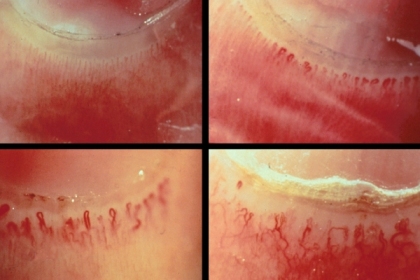
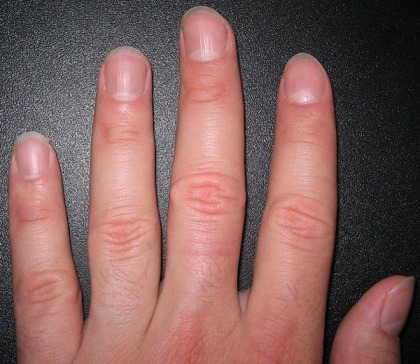




 “The nail of the thumb in this condition is often very short and wide. It is usually hereditary, although it could also have been caused by frostbite, or it could have been an injury to the growth plate in childhood. While one is young, the thumb often looks more or less ordinary, but with the passing of time its shortened condition begins to stand out more and more.”
“The nail of the thumb in this condition is often very short and wide. It is usually hereditary, although it could also have been caused by frostbite, or it could have been an injury to the growth plate in childhood. While one is young, the thumb often looks more or less ordinary, but with the passing of time its shortened condition begins to stand out more and more.”



